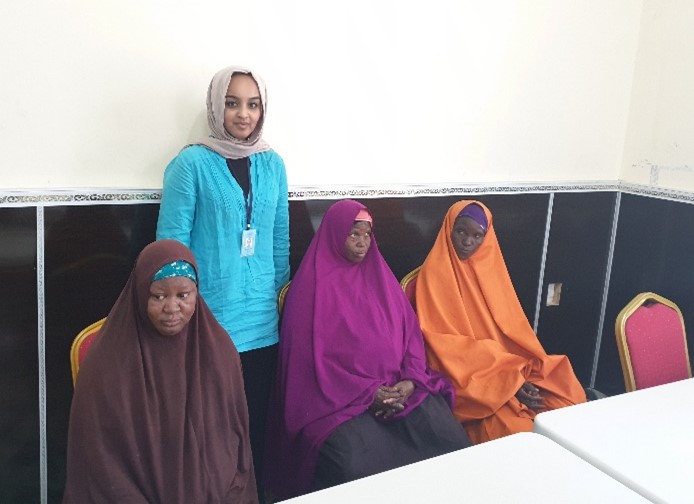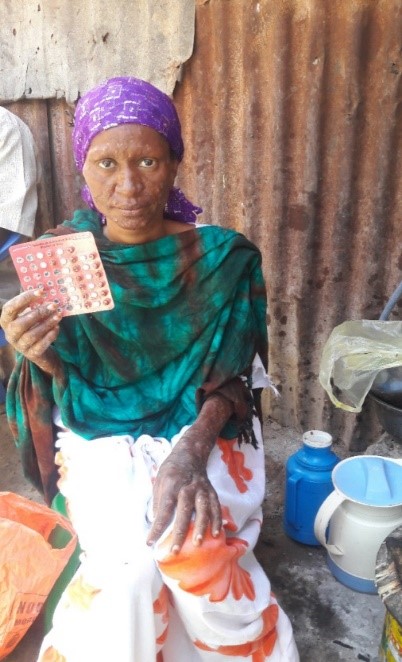 A technical officer from the WHO Regional Office for the Eastern Mediterranean, Dr Mona Osman, after a discussion with patients. Credit: WHO30 January 2022 – In May 2021, the World Health Assembly resolved to dedicate 30 January each year as World Neglected Tropical Diseases Day to shed light on the public health challenge that neglected tropical diseases (NTDs) pose in countries such as Somalia. This came about as a result of lobbying from the United Arab Emirates to galvanize support for communities suffering without enough support, particularly as other disease control initiatives gain more attention. This year, the theme for World Neglected Tropical Diseases Day is ‘Achieving health equity to end the neglect of poverty-related diseases.’
A technical officer from the WHO Regional Office for the Eastern Mediterranean, Dr Mona Osman, after a discussion with patients. Credit: WHO30 January 2022 – In May 2021, the World Health Assembly resolved to dedicate 30 January each year as World Neglected Tropical Diseases Day to shed light on the public health challenge that neglected tropical diseases (NTDs) pose in countries such as Somalia. This came about as a result of lobbying from the United Arab Emirates to galvanize support for communities suffering without enough support, particularly as other disease control initiatives gain more attention. This year, the theme for World Neglected Tropical Diseases Day is ‘Achieving health equity to end the neglect of poverty-related diseases.’
Prevalence of NTDs in Somalia
NTDs are known to be ‘neglected’ owing to the lack of attention they receive, including from the donor community, policy-makers and stakeholders. The NTDs in Somalia are a consequence and cause of poverty as they thrive where access to clean water, sanitation and health care is limited. They affect the poorest, most marginalized communities, particularly children, women and the elderly, and those who lack access to basic needs like clean water. In Somalia, they impact communities living in rural and remote settings and the outskirts of big towns. These diseases cause immeasurable suffering, and prevent adults from being able to work and children from being able to go to school.
Of the 20 NTDs listed by WHO as endemic in tropical countries, the most prevalent in Somalia are: leprosy, schistosomiasis, soil-transmitted helminthiases and visceral leishmaniasis. About 5 to 6 million people in the country live in areas that are highly endemic for these NTDs. On the occasion of World Neglected Tropical Disease Day, WHO and its partners renew their call to address the health inequity that is the main driver for people suffering from NTDs to access quality health care and as a result, these ancient diseases continue to thrive and impact health and productivity.
Somalia a global priority for leprosy control
In 2019, as Somalia was one of 16 countries reporting more than 1000 new cases of leprosy, the WHO Global Leprosy programme classified it as a global priority country. Even before this though, the Federal Ministry of Health and Human Services had been working to respond to this disease. In August 2015, the Ministry of Health established an NTD section, after which the detection of new leprosy patients improved, and increased from 107 in 2015 to 2638 in 2021, despite a global drop in cases reported and detected in 2020 due to the spread of the coronavirus disease 2019 (COVID-19). The overall increase in detection of new leprosy cases in Somalia is also linked to support received from the Nippon Foundation, which has been supporting Somalia for the last several years to conduct outreach and raise awareness around leprosy, enhance screening of patients, and support leprosy patients with treatment so they are non-infectious.
Lack of awareness leads to social exclusion
 Culimo shares her experiences of living with leprosy, also known as Hansen’s disease Credit: Ali Abdi IsackAt the age of 19, Culimo Osmal Hilowle contracted leprosy – a disease that she didn’t know much about – despite having no memory of how she got infected. Even though she didn’t have any physical disability, she started to present with sores on her skin.
Culimo shares her experiences of living with leprosy, also known as Hansen’s disease Credit: Ali Abdi IsackAt the age of 19, Culimo Osmal Hilowle contracted leprosy – a disease that she didn’t know much about – despite having no memory of how she got infected. Even though she didn’t have any physical disability, she started to present with sores on her skin.
“Everyone I know was afraid I would spread this disease to them,” Culimo says. “They isolated me. At some point I even started to believe that I had a mental disability, but once I started to receive treatment, I knew I couldn’t infect anyone and felt much better as I integrated into the society again.”
Culimo owns a small shop where she sells vegetables every day, to support her 2 boys alongside her husband.
Leprosy can be treated, cured and stopped if it is detected in good time. “It would be good for more people to learn about forgotten diseases like leprosy. Now that people around me know more about the disease, they treat me well and support me.”
Additional resources needed to fight NTDs and increase health equity
Besides leprosy, it is estimated that 9 of the most endemic regions for NTDS in Somalia are also affected by visceral leishmaniasis. For several years, there have only been 3 main treatment centres, situated in two regions of Bakool and Bay and supported by WHO with capacity-building and medicines, that provide services to support patients suffering from visceral leishmaniasis. Most patients who come in with this disease are from rural areas, where they may have limited access to health services. Even though the local communities in these locations, in collaboration with international and local nongovernmental organizations, provide support to address visceral leishmaniasis, there is a need to have additional capacity to address NTDs like this.
In 2016, a study noted that most schistosomiasis and soil-transmitted helminth cases were found in the regions in the South West state of Somalia. In response, from 2017 to 2020, WHO supported the Ministry of Health to offer medicines using mass drug administration activities. In 2020, WHO and the Ministry of Health offered medication to around 2 909 457 school-aged children and adults to protect them schistosomiasis and soil-transmitted helminth infections.
Taking measures to address NTDs
WHO Somalia is supporting the Ministry of Health to reduce the prevalence of NTDs, by offering technical support, mobilizing resources, including medical drugs, and increasing coordination between donors and the Federal Government of Somalia to fight NTDs. Key donors supporting the fight against NTDs include the Nippon Foundation, the Government of Japan, and The END Fund, alongside support from the WHO Regional Office for the Eastern Mediterranean.
“In a two-pronged approach, WHO is supporting the Government to respond to NTDs, while also working to ensure all Somalis have equitable access to health services through universal health coverage,” said Dr Mamunur Rahman Malik, WHO Representative to Somalia and Head of Mission. “In the very near future, WHO and the Government aim to develop the national strategy for elimination and control of NTDs, running from 2022 to 2025, which will increase the capacity of institutions to prevent and respond to NTDs and support patients in a holistic manner, no matter where they live. Our Country Cooperation Strategy 2021–2025 aims to ensure a healthy future for every Somali by accelerating the uptake and coverage mass drug administration through improving access to care which remains the main intervention for control of NTDs. However, we will need more support from policy-makers, donors and stakeholders to make this a reality.”
NTDs are strongly linked to universal health coverage (Target 3 of the Sustainable Development Goals). The WHO country office renews its pledge and promises on leaving no one behind. Providing access to health services and essential medicines for NTDs is an indicator of the overall success of universal health coverage.




